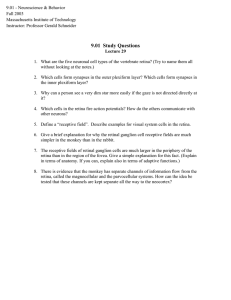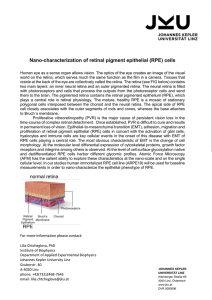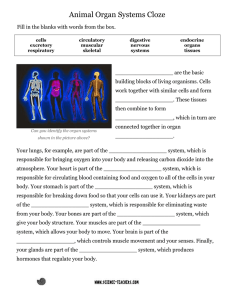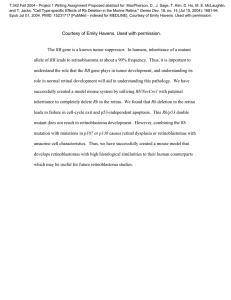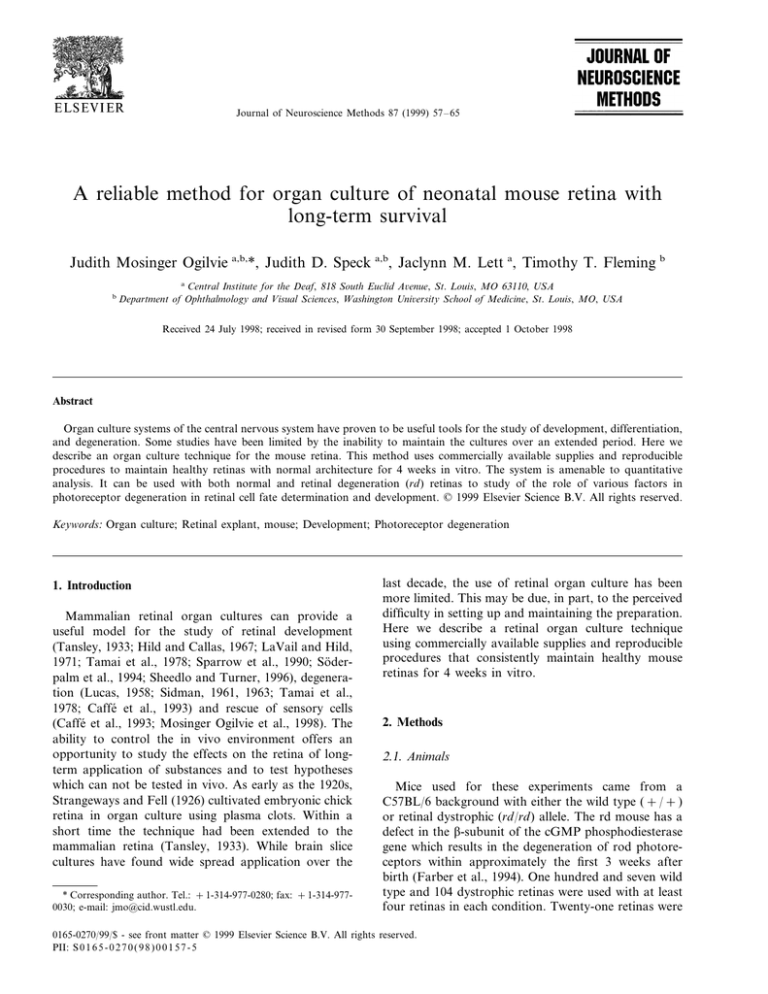
Journal of Neuroscience Methods 87 (1999) 57 – 65
A reliable method for organ culture of neonatal mouse retina with
long-term survival
Judith Mosinger Ogilvie a,b,*, Judith D. Speck a,b, Jaclynn M. Lett a, Timothy T. Fleming b
b
a
Central Institute for the Deaf, 818 South Euclid A6enue, St. Louis, MO 63110, USA
Department of Ophthalmology and Visual Sciences, Washington Uni6ersity School of Medicine, St. Louis, MO, USA
Received 24 July 1998; received in revised form 30 September 1998; accepted 1 October 1998
Abstract
Organ culture systems of the central nervous system have proven to be useful tools for the study of development, differentiation,
and degeneration. Some studies have been limited by the inability to maintain the cultures over an extended period. Here we
describe an organ culture technique for the mouse retina. This method uses commercially available supplies and reproducible
procedures to maintain healthy retinas with normal architecture for 4 weeks in vitro. The system is amenable to quantitative
analysis. It can be used with both normal and retinal degeneration (rd) retinas to study of the role of various factors in
photoreceptor degeneration in retinal cell fate determination and development. © 1999 Elsevier Science B.V. All rights reserved.
Keywords: Organ culture; Retinal explant, mouse; Development; Photoreceptor degeneration
1. Introduction
Mammalian retinal organ cultures can provide a
useful model for the study of retinal development
(Tansley, 1933; Hild and Callas, 1967; LaVail and Hild,
1971; Tamai et al., 1978; Sparrow et al., 1990; Söderpalm et al., 1994; Sheedlo and Turner, 1996), degeneration (Lucas, 1958; Sidman, 1961, 1963; Tamai et al.,
1978; Caffé et al., 1993) and rescue of sensory cells
(Caffé et al., 1993; Mosinger Ogilvie et al., 1998). The
ability to control the in vivo environment offers an
opportunity to study the effects on the retina of longterm application of substances and to test hypotheses
which can not be tested in vivo. As early as the 1920s,
Strangeways and Fell (1926) cultivated embryonic chick
retina in organ culture using plasma clots. Within a
short time the technique had been extended to the
mammalian retina (Tansley, 1933). While brain slice
cultures have found wide spread application over the
* Corresponding author. Tel.: +1-314-977-0280; fax: + 1-314-9770030; e-mail: jmo@cid.wustl.edu.
last decade, the use of retinal organ culture has been
more limited. This may be due, in part, to the perceived
difficulty in setting up and maintaining the preparation.
Here we describe a retinal organ culture technique
using commercially available supplies and reproducible
procedures that consistently maintain healthy mouse
retinas for 4 weeks in vitro.
2. Methods
2.1. Animals
Mice used for these experiments came from a
C57BL/6 background with either the wild type (+/+)
or retinal dystrophic (rd/rd) allele. The rd mouse has a
defect in the b-subunit of the cGMP phosphodiesterase
gene which results in the degeneration of rod photoreceptors within approximately the first 3 weeks after
birth (Farber et al., 1994). One hundred and seven wild
type and 104 dystrophic retinas were used with at least
four retinas in each condition. Twenty-one retinas were
0165-0270/99/$ - see front matter © 1999 Elsevier Science B.V. All rights reserved.
PII: S 0 1 6 5 - 0 2 7 0 ( 9 8 ) 0 0 1 5 7 - 5
58
J. Mosinger Ogil6ie et al. / Journal of Neuroscience Methods 87 (1999) 57–65
used in preliminary experiments described below. Animals were handled in accordance with institutional
guidelines and the National Institutes of Health Guidelines on Laboratory Animal Welfare.
2.2. Organ cultures
Mouse pups at postnatal day 2 (P2) were anesthetized on crushed ice and decapitated. The head was
dipped in 70% ethanol and moved to a laminar flow
hood where sterile procedures were maintained for the
remainder of the preparation. Eyes were enucleated and
placed in cold Dulbecco’s modified Eagle’s media
(DMEM, Gibco c 11965) plus 2.5 mg/ml Fungizone
(Sigma, St. Louis, MO) in a 35-mm petri dish. Using
fine forceps, extraneous connective tissue was removed
from the globe which was then placed in fresh DMEM
containing 0.5% proteinase K (Boehringer Mannheim,
Germany) for approximately 7 min at 37°C. The tissue
was rinsed at room temperature in DMEM plus 10%
fetal calf serum (FCS) and 1.25 mg/ml Fungizone and
then replaced with the same media without serum.
Starting at the limbus border, the sclera and choroid
were gently peeled away using two pair of c 5 forceps
leaving the retinal pigment epithelia (RPE) attached to
the retina. Using the same forceps, each retina was
isolated from its anterior segment (cornea, lens and
vitreous) with as little disruption and manipulation as
possible. The tissue was then gently lifted with a pair of
forceps and transferred to a fresh petri dish containing
DMEM plus 10% FCS and 1.25 mg/ml Fungizone and
incubated for approximately 30 min at 37°C. RPE
sheets, which detach from the retinas during this process and begin to roll up, were gently teased away from
the retina using fine forceps, leaving a few RPE cells
behind. Using a disposable transfer pipette which had
the tip cut to enlarge the opening, each retina was
gently transferred with a few drops of media onto the
center of a Millipore Millicell-CM culture insert (0.4
mm, 30 mm) with the photoreceptor side down. Some
media was removed to prevent the retina from floating
free while trying to manipulate it into position. A fine
tipped glass probe was used to tease and flatten the
edges of each retina. The glass probe was made by
pulling a Pasteur pipette over a flame and then by fire
polishing to get a closed-bore tip. Only minimal manipulations were performed since minor disruptions of the
tissue during isolation and plating lead to significant
distortion over time. Inserts were placed in six well
plates containing approximately 1 ml/well of medium.
The culture medium was comprised of DMEM with
FCS (10%) and Fungizone (1.25 mg/ml). All excess
medium was removed from the membrane leaving only
a moist film covering the tissue. Cultures were maintained at 37°C, 5% CO2, and fed every 2 – 3 days by
replacing 0.5 ml of media.
Early experiments with Anocell (c 25) and Falcon
(c 3090) inserts were less successful than organ cultures
grown on the Millicell-CM insert; we have not tested
other culture inserts. In some preliminary experiments,
after the eyes were enucleated and placed in cold
DMEM plus 10% FCS, the sclera, choroid and RPE
were peeled away mechanically without enzyme treatment. In other experiments, only the sclera and choroid
were removed and the retina and RPE were co-cultured
on the Millicell membranes.
2.3. Histology
Organ cultures were terminated after a period ranging from 4 h to 41 days in vitro (DIV 0–41) by placing
them in fixative with 2.5% glutaraldehyde and 2%
paraformaldehyde overnight. Eyecups from agematched control animals, were also isolated and fixed
to provide an in vitro comparison. Surviving littermates
were used when available. Tissue was postfixed for 1 h
in 1% osmium tetroxide, stained en bloc with 1% uranyl
acetate for 1 h, rinsed, dehydrated through an acetone
series and embedded in Epon-Araldite. For electron
microscopy, silver or light gold sections were cut on a
diamond knife and post-stained with uranyl acetate and
lead citrate.
2.4. Data analysis
A trained observer, blind to the experimental conditions, viewed the retinal sections through a light microscope at 40 × magnification. Using a grid reticule to
determine length, the center of the section was identified and two regions, 100 mm on either side of the
center point, were randomly selected for three quantitative measurements. First, the thickness of the outer
nuclear layer (ONL) was determined by counting the
number of ONL cells in a vertical column touching a
single grid line on the reticule. Five counts were taken
across an 80 mm region (20 mm intervals) on both sides
of the center point for a total of ten measures, which
were averaged for each retina. The total number of
ONL nuclei and the number of pyknotic nuclei were
counted in both regions to determine the percent of
pyknotic cells in the ONL. Finally, inner and outer
segments within each 80 mm region were ranked on a
scale of 0–3 where: 3, full-length inner segments (IS)
and many identifiable outer segments (OS); 2, full-to
moderate-length IS and few OS; 1, moderate-to-shortened IS and no OS; 0, few small, rounded IS or none
remaining. In some cases, the region 100 mm to the side
of the center point contained a rosette or distortion due
to folding. These retinas were counted both in the
designated region and in the first adjacent flat area.
Since the distortions generally resulted in a thickening
of the ONL at the center of the rosette with an adjacent
J. Mosinger Ogil6ie et al. / Journal of Neuroscience Methods 87 (1999) 57–65
59
thinning, no significant difference was found between
randomly selected areas compared to flat selected areas
in the average thickness of the ONL or the percent of
pyknotic cells, although the standard deviation was
larger for the former. In order to minimize any observer
bias that might impinge on the selection of the region
to be counted, the randomly selected area (100 mm from
the center point) was used for all reported measures.
However, adjacent flat areas were observed for determination of the IS and OS integrity. These observations
varied little across the length of the retinas. A one way
analysis of variance (ANOVA) on ranks was performed
on the data from different experimental conditions.
3. Results
3.1. De6elopment of normal retina in 6itro
At P2, when tissue is harvested for organ culture, the
retina is comprised primarily of a neuroblast layer
(NBL). The ganglion cell layer (GCL) and inner plexiform layer (IPL) have differentiated; some cells on the
inner margin of the NBL have the appearance of
amacrine cells (Young, 1984). Cells undergoing mitosis
can be identified at the outer margin of the NBL. After
24 h in vitro, organ culture retinas show inner retinal
swelling and cell loss in the GCL (Fig. 1A). This
observation is consistent with previous findings that
neonatal axotomy is followed by ganglion cell death
(Miller and Oberdorfer, 1981) but has only a minimal
effect on the survival of other retinal neurons (Beazley
et al., 1987). Mitotic profiles at the outer margin
provide evidence of continued differentiation of the
NBL. Horizontal cell differentiation first appears at this
stage both in vitro and in vivo and is characterized by
differentiated cell nuclei in the center of the NBL.
Although retinas grown in vitro are thinner than their
age-matched controls (Fig. 1B), they otherwise look
very similar to retinas from their P3 littermates.
By 8 DIV the retina has differentiated into three
nuclear and two plexiform layers similar in appearance
to the in vivo control retinas (Fig. 1C, D). The GCL is
comprised of a monolayer of cell bodies. Cells in the
ONL have differentiated with the characteristic chromatin pattern of photoreceptors. Dense, round apoptotic cells can be seen in both the in vitro and in vivo
retinas, consistent with developmental programmed cell
death which occurs in the retina through P18 (Young,
1984). IS development in the organ culture is comparable in length to in vivo controls at this age, but does not
have the tightly-packed appearance. By 12 DIV, thin
processes extending from the IS with overlying wispy
material can be seen. These are identified as connecting
cilia and OS disk membranes in the electron microscope
(EM, see below). Although RPE sheets are detached
Fig. 1. Light micrographs from retinas grown in organ culture (A, C)
or age-matched controls (B, D). The organ culture retina (A) is
thinner than the age-matched control (B) after 1 day in vitro (DIV)
and swelling in the inner retinal layers from ganglion cell death is
apparent. In both retinas, mitotic profiles (arrowheads) can be seen
on the outer margin and differentiating horizontal cells (arrows) can
be distinguished in the NBL. After 8 DIV, both the organ culture (C)
and age-matched control (D) retinas show retinal cell differentiation,
IS development, and developmental cell death characterized by pyknotic nuclei (arrows). A likely RPE cell with thin processes extending laterally overlies the in vitro retina (arrowhead). NBL, neuroblast
layer; RPE, retinal pigment epithelium; IS, inner segments; ONL,
outer nuclear layer; OPL, outer plexiform layer; INL, inner nuclear
layer; IPL, inner plexiform layer; GCL, ganglion cell layer. Scale
bar =20 mm. In this and all subsequent figures, conventional negatives were scanned and electronically inverted to a positive image;
montages were assembled digitally.
60
J. Mosinger Ogil6ie et al. / Journal of Neuroscience Methods 87 (1999) 57–65
Fig. 2. Light micrographs from retinas grown to maturity in organ culture (A, B, D) or 22 day in vivo control (C). Note that overall retinal
architecture is maintained. Other than thinning of the retina, few differences are seen between 20 DIV (A) and 28 DIV (B). RPE overlies much
of the organ culture. Inner segments and thin, wispy outer segment material (arrowheads) are sparsely distributed in the subretinal space. (D) At
lower magnification, folds and rosettes are apparent in the outer nuclear layer of the 28 DIV organ culture (arrows). RPE, retinal pigment
epithelium; OS, outer segments; IS, inner segments; ONL, outer nuclear layer; OPL, outer plexiform layer; INL, inner nuclear layer; IPL, inner
plexiform layer; GCL, ganglion cell layer. A–C, scale bar = 20 mm; D, scale bar = 200 mm.
during the isolation process, a few RPE cells always
remain. At early times points, rounded cells with long
thin processes extending laterally are frequently seen at
the outer margin of the tissue, sitting in the position of
RPE above the developing IS. The cells often have
pigment granules at early time points identifying them
as RPE cells. As the organ culture develops, these cells
become more elongated, loose their pigmentation, but
can be identified as RPE cells by their characteristic
apical processes and EM appearance (see below). The
edges of the organ culture are very thin and may be
disorganized reflecting any folding or disruption to the
edge of the tissue that occurred at the time of isolation
and plating.
The overall retinal architecture in organ cultures is
maintained through 28 DIV. Other than an overall
thinning of the retina, few differences are seen between
20 and 28 DIV (Fig. 2A, B). The IS extend further from
the external limiting membrane and many thin wispy
processes can be seen. In vivo littermates have mature
OS at this age (Fig. 2C). Cell bodies in the GCL are
still present after 4 weeks in culture but comprise less
J. Mosinger Ogil6ie et al. / Journal of Neuroscience Methods 87 (1999) 57–65
61
Fig. 3. Light micrographs from rd mouse retinas grown to maturity in organ culture (A, B, D) or 22 day in vivo control (C). (A) At 20 DIV, the
outer nuclear layer is reduced to two to four rows of cells and inner segments are stunted (arrowheads). (B) By 27 DIV, the outer nuclear layer
is reduced to one to two rows of cells and only residual inner segments remain similar to the in vivo rd retina at P22 (C). Overall retinal
architecture is maintained through 27 DIV (D) without folds or rosettes. RPE, retinal pigment epithelium; ONL, outer nuclear layer; OPL, outer
plexiform layer; INL, inner nuclear layer; IPL, inner plexiform layer; GCL, ganglion cell layer. A – C, scale bar =20 mm; D, scale bar =200 mm.
than a monolayer. The RPE cells form a monolayer
overlying some areas of the retina. The edges of the
culture taper off end may be disorganized (Fig. 2D) due
to some folding or disruption at the time of isolation.
In mature organ culture retinas, folding and rosette
formation in the ONL appears interspersed with flat
areas (Fig. 2D). This disruption in the ONL is usually
confined to the edges of the organ culture at 8 DIV, is
slightly more apparent at 12 DIV, and becomes significantly more pronounced by 4 weeks.
3.2. Alternate isolation techniques
In preliminary experiments, we tried to transfer the
RPE intact with the retina into organ culture. On the
Millicell membranes, the RPE lost its epithelial integrity resulting either in large clumps of RPE cells,
which would cause displacement of retinal layers, or in
migration and invasion of RPE cells into the retina
with disruption of retinal architecture. Removal of the
RPE cells through mechanical isolation caused more
extensive folding and rosette formation in the ONL
than isolation with proteinase K treatment. This is
likely to be a result of subjecting the sensitive retina to
additional handling during mechanical isolation. Some
RPE cells remained attached to the retina with either
treatment. Over a period of weeks, these RPE cells
developed into a layer underlying the organ culture,
that varied from an intact monolayer in some areas to
sparse, thin cells in other areas while a few regions
appear devoid of RPE cells. Few pigment granules were
seen consistent with the progressive depigmentation of
isolated RPE cells grown in culture. These residual
RPE cells were not observed to invade the retina or
disrupt the retinal architecture.
3.3. De6elopment of rd retina in 6itro
During the first week in organ culture, retinas from
rd mice cannot be distinguished from wild type retinas.
By 20 DIV, the ONL is reduced to an average of 2.8
rows of cells in the rd retina and many pyknotic cells
can be identified (Figs. 3A and 4). However, the ONL
of the rd organ culture is thicker than in vivo
62
J. Mosinger Ogil6ie et al. / Journal of Neuroscience Methods 87 (1999) 57–65
littermates where only a monolayer of cells remain in
the ONL (Fig. 3C). IS are still apparent in vitro, but
have a stubby appearance and the fine wispy OS pro-
cesses seen in the normal retinas can not be identified.
RPE cells, when present, often sit directly above or
surrounding IS. Inner retinal layers appear similar in
both the rd and wild type organ cultures. By 27 DIV,
the ONL in the rd retina has narrowed to approximately 1.5 cells thick (Figs. 3B and 4), approaching the
monolayer appearance of the in vivo littermates. ONL
folding and rosette formation are rarely seen in the rd
organ cultures (Fig. 3D). Organ cultures can be maintained for as long as 6 weeks in vitro, however, they
become so thin that retinal architecture is compromised.
3.4. E6aluation of retinal cultures using EM
IS with connecting cilia can clearly be identified
extending beyond the outer limiting membrane in 3–4
week organ cultures of wild type retina (Fig. 5A).
Stacked and free-floating OS membranes, which clearly
correspond to the thin wispy processes identified in the
light microscope, extend from the cilia into a subretinal
space separated from the RPE. These OS disks are
sparsely scattered beyond the IS, but are more densely
packed adjacent to RPE. RPE cells may appear
rounded or elongated with nuclei that are easily distinguished from displaced photoreceptors by the diffuse
heterochromatin pattern. Microvillar processes extend
toward the OS from overlying RPE cells. Thin Müller
cell processes extend beyond the junctions which form
the external limiting membrane. A row of photoreceptor synaptic terminals in the outer plexiform layer
(OPL) form invaginating ribbon synapses (Fig. 5B)
with some vacuolization in the terminals. The IPL has
an overall normal appearance with both ribbon and
conventional synapses (Fig. 5C).
In the 3 week rd organ culture, IS, some with connecting cilia, can be clearly identified, but OS membranes are very sparse (Fig. 5D). Some free-floating
membranes, which may be residual OS, are present.
The thin Müller cell processes appear more numerous
than in wild type organ cultures, consistent with gliosis
seen in the in vivo rd retina. After 4 weeks in vitro, IS
become smaller and more stunted. Synaptic terminals
can still be seen although they are fewer in number and
ribbons often appear in the cytoplasm of the cell body
(Fig. 5E), as is seen in the in vivo degenerating photoreceptors (Carter-Dawson et al., 1978). The IPL shows no
obvious differences from the wild type.
Fig. 4. Measure of outer nuclear layer thickness (A), percent of
pyknotic cells in the outer nuclear layer (B), and inner/outer segment
development (C) in retinal organ cultures of normal and rd retinas at
20 and 27 DIV. Note that no significant differences are seen in the
normal retina between 20 and 27 days. The rd retina shows significant
loss in all three measures at 20 days and further loss after 27 days in
culture. See Section 2 for explanation of inner and outer segment
ranking. Bars indicate the standard deviation. * pB 0.05 compared to
age-matched controls.
4. Discussion
The first organ culture of eye tissue was performed
by placing whole embryonic chick eyes in plasma clots
(Strangeways and Fell, 1926). Tansley (1933) advanced
the technique by extending the methods to mammalian
J. Mosinger Ogil6ie et al. / Journal of Neuroscience Methods 87 (1999) 57–65
63
Fig. 5. Electron micrographs from retinas of normal (A–C) and rd (D, E) retinas grown to maturity in organ culture. (A) At 20 DIV, inner
segments filled with mitochondria are separated by thin Müller cell processes reaching beyond the outer limiting membrane (arrowhead).
Connecting cilia extend from the inner segments (arrows). Stacks of outer segment disks are attached to the cilia (inset) and sparsely scattered
above the inner segments. (B) Photoreceptor terminals form invaginating ribbon synapses (arrowheads) in the outer plexiform layer of the normal
28 DIV organ culture. (C) Both conventional (arrow) and ribbon (arrowhead) synapses can be seen in the inner plexiform layer of the normal
20 DIV organ culture. (D) In the 20 DIV rd organ culture, fewer inner segments are seen and many appear shortened (large arrowheads).
Occasional connecting cilia can still be found (arrow) with some outer segment-like membranes attached (inset) or free floating (small arrowhead).
Müller cell processes are more numerous. (E) Ribbon synapses are sparse in the outer plexiform layer of the 27 DIV rd organ culture and often
appear retracted within the cytoplasm of the cell body (arrow). Magnification for A, D: 3100 × (insets: 10 900 ×); B, E: 9100 ×; C: 18 000 × .
tissue and by isolating the rat retina from the whole
eyecup. Retinal explant cultures in the first half of the
century were primarily grown in plasma clots using a
roller tube method. The roller tube culture, also known
as the flying coverslip method, maintains a stable attachment of the tissue by embedding it in a plasma clot
or collagen matrix affixed to a coverslip which undergoes a continuous, slow rotation. Variations on this
method have continued to be used (Hild and Callas,
1967; LaVail and Hild, 1971; Feigenspan et al., 1993).
In the 1950s, Trowell (1954) developed the membrane
culture in which the tissue is placed on a porous
membrane such as lens or filter paper on top of a wire
grid and maintained at the air-media interface. This
technique was used by him and others for retinal explants (Lucas, 1958; Lucas and Trowell, 1958; Sidman,
1961; Tamai et al., 1978). Caffé et al. (Caffé et al., 1989;
Caffé and Sanyal, 1991) have developed a method
which combines some features of both membrane and
roller tube techniques by placing rafts made of nitrocel-
64
J. Mosinger Ogil6ie et al. / Journal of Neuroscience Methods 87 (1999) 57–65
lulose filters and polyamide gauze grids on a rocking
device.
The techniques described here rely on commercially
available membranes and reproducible procedures to
consistently produce healthy mouse retinas for 4 weeks
in vitro. These retinas follow the same developmental
time course as in vivo littermates. However, they show
incomplete development of OS and formation of
rosettes in the ONL. Rosette formation is a common
feature of explants of developing retina and has been
attributed to the absence of intraocular pressure, a
condition which also produces rosettes and folding in
vivo (Tansley, 1933; Coulombre, 1956; Hild and Callas,
1967). The incomplete development of OS is also a
common feature of photoreceptors in culture. It may be
partially due to the sparseness of the overlying RPE
since the pigment epithelium has been shown to be
important for photoreceptor development (Sheedlo and
Turner, 1995) and specifically for OS development in
culture (Hollyfield and Witkovsky, 1974; Spoerri et al.,
1988). No difference in OS development is seen between
regions with continuous overlying RPE and regions
with no overlying RPE, consistent with a diffusible
factor. This retinal organ culture model differs from
others previously described in the growth of a new layer
of RPE from a few residual cells. The nature of the
underlying membrane may play a role in RPE growth.
Interestingly, a subretinal space is maintained between
the normal retina and the RPE even though this space
is only sparsely filled with OS membranes. In the rd
organ cultures, little separation is observed between the
degenerating photoreceptors and the RPE.
The rd mouse carries a genetic mutation leading to
the degeneration of the rod photoreceptors during the
first 3 weeks. This mouse has proved an excellent model
for the study of Retinitis Pigmentosa, a human retinal
degenerative disease. The development of an organ
culture model of the rd retina allows for investigations
that have been limited by the small size of the mouse
eye. Photoreceptor degeneration can be described quantitatively in this organ culture model of the rd mouse
retina. Loss of photoreceptors is slightly delayed in the
explants of rd mouse retinas compared to in vivo
littermates. Lucas (1958) made a similar observation
and suggested that photoreceptor degeneration in vitro
occurs at a slower rate because of delayed differentiation. This hypothesis is based on his observation that
photoreceptors in organ culture failed to develop IS
and OS, although they do undergo nuclear differentiation at the same time as in vivo photoreceptors (Lucas
and Trowell, 1958). In the organ culture system described here, however, IS and OS development is not
delayed although development appears incomplete. Alternatively, the slower rate of photoreceptor degeneration may be due to survival factors in the fetal calf
serum in the media. In addition to quantitative studies
of photoreceptor degeneration, the organ culture model
provides a system for studies of ganglion cell death
following axotomy, making the model a valuable tool
for the study of degeneration of two different cell types
in the retina. The organ culture also provides a controlled environment for the study of the role of various
factors in retinal cell fate determination and development.
We have described here a retinal organ culture model
which can play an important role in understanding the
mechanism of photoreceptor degeneration and rescue.
This model provides several advantages over other
methods that have been used for screening possible
therapeutic agents. Isolated photoreceptor cultures may
be simpler than organ cultures, but lack the cell–cell
interactions of normal retinal architecture that may
play a role in cell survival. Injection of growth factors
directly into the vitreous has the advantages of an in
vivo model, but the small eye of the young mouse
makes it extremely difficult, if not impossible, to ensure
that a consistent dose is injected without leakage. Furthermore, with intravitreal injections the dose decreases
with the metabolic turnover of the vitreous, requiring
multiple injections for 4 week survival times. The organ
culture model provides a middle course which allows
for a constant and controlled dose for the duration of
the 4 week exposure while maintaining the integrity of
the retinal architecture and cell–cell interactions. It is
amenable to quantitative analysis which will support
further studies of underlying mechanisms.
Acknowledgements
The authors would like to thank Dr Martin S. Silverman for his many useful contributions and Ann Benz
for technical advice. This work was supported by NIH
Grants NS01756 (JMO), EY11360 (TTF), EY02687,
the Foundation Fighting Blindness (JMO) and an unrestricted grant to the Department of Ophthalmology and
Visual Sciences from Research to Prevent Blindness.
References
Beazley L, Perry V, Baker B, Darby J. An investigation into the role
of ganglion cells in the regulation of division and death of other
retinal cells. Dev Brain Res 1987;33:169 – 84.
Caffé AR, Sanyal S. Retinal degeneration in vitro: Comparison of
postnatal retinal development of normal, rd and rds mutant mice
in organ culture. In: Anderson RE, Hollyfield JG, LaVail MM,
editors. Retinal Degenerations. Boca Raton, FL: CRC Press,
1991:29 – 38.
Caffé AR, Söderpalm A, van Veen T. Photoreceptor-specific protein
expression of mouse retina in organ culture and retardation of rd
degeneration in vitro by a combination of basic fibroblast and
nerve growth factors. Curr Eye Res 1993;12:719 – 26.
J. Mosinger Ogil6ie et al. / Journal of Neuroscience Methods 87 (1999) 57–65
Caffé AR, Visser H, Jansen HG, Sanyal S. Histotypic differentiation
of neonatal mouse retina in organ culture. Curr Eye Res
1989;8:1083 – 92.
Carter-Dawson LD, LaVail MM, Sidman RL. Differential effect of
the rd mutation on rods and cones in the mouse retina. Invest
Ophthalmol Vis Sci 1978;17:489–98.
Coulombre A. The role of intraocular pressure in the development of
the chick eye. J Exp Zool 1956;133:211–25.
Farber DB, Flannery JG, Bowes-Rickman C. The rd mouse story:
seventy years of research on an animal model of inherited retinal
degeneration. Prog Ret Eye Res 1994;13:31–64.
Feigenspan A, Bormann J, Wässle H. Organotypic slice culture of the
mammalian retina. Vis Neurosci 1993;10:203–17.
Hild W, Callas G. The behavior of retinal tissue in vitro, light and
electron microscopic observations. Z Zellforsch 1967;80:1– 21.
Hollyfield JG, Witkovsky P. Pigmented retinal epithelium involvement in photoreceptor development and function. J Exp Zool
1974;189:357 – 78.
LaVail MM, Hild W. Histotypic organization of the rat retina in
vitro. Z Zellforsch 1971;114:557–79.
Lucas DR. Inherited retinal dystrophy in the mouse: its appearance
in eyes and retinae cultured in vitro. J Embryol Exp Morph
1958;6:589 – 92.
Lucas DR, Trowell OA. In vitro culture of the eye and the retina of
the mouse and rat. J Embryol Exp Morph 1958;6:178–82.
Miller NM, Oberdorfer M. Neuronal and neuroglial responses following retinal lesions in the neonatal rats. J Comp Neurol
1981;202:493 – 504.
Mosinger Ogilvie J, Speck JD, Lett JM. Trophic factors increase
photoreceptor survival in rd mouse retinal organ cultures. Invest
Ophthalmol Vis Sci 1998;39:S571.
Sheedlo HJ, Turner JE. Photoreceptor survival and development in
culture. Prog Ret Eye Res 1995;15:127–37.
.
65
Sheedlo HJ, Turner JE. Influence of a retinal pigment epithelial cell
factor(s) on rat retinal progenitor cells. Dev Brain Res
1996;93:88 – 99.
Sidman RL. Tissue culture studies of inherited retinal dystrophy. Dis
Nerv Sys 1961;22:14 – 20.
Sidman RL. Organ-culture analysis of inherited retinal degeneration
in rodents. Natl Cancer Inst Monogr 1963;11:227 – 46.
Söderpalm A, Szél A, Caffé AR, van Veen T. Selective development
of one cone photoreceptor type in retinal organ culture. Invest
Ophthalmol Vis Sci 1994;35:3910 – 21.
Sparrow JR, Hicks D, Barnstable CJ. Cell commitment and differentiation in explants of embryonic rat neural retina. Comparison
with the developmental potential of dissociated retina. Dev Brain
Res 1990;51:69 – 84.
Spoerri PE, Ulshafer RJ, Ludwig HC, Allen CB, Kelley KC. Photoreceptor cell development in vitro: influence of pigment epithelium
conditioned medium on outer segment differentiation. Eur J Cell
Biol 1988;46:362 – 7.
Strangeways TSP, Fell HB. Experimental studies on the differentiation of embryonic tissues growing in vivo and in vitro. II. The
development of the isolated early embryonic eye of the fowl when
cultivated in vitro. Proc R Soc 1926;100:273 – 83.
Tamai M, Takahashi J, Noji T, Mizuno K. Development of photoreceptor cells in vitro: influence and phagocytic activity of homoand heterogenic pigment epithelium. Exp Eye Res 1978;26:581–
90.
Tansley K. The formation of rosettes in the rat retina. Br J Ophthalmol 1933;17:321 – 36.
Trowell OA. A modified technique for organ culture in vitro. Exp
Cell Res 1954;6:246 – 8.
Young RW. Cell death during differentiation of the retina in the
mouse. J Comp Neurol 1984;229:362 – 73.

